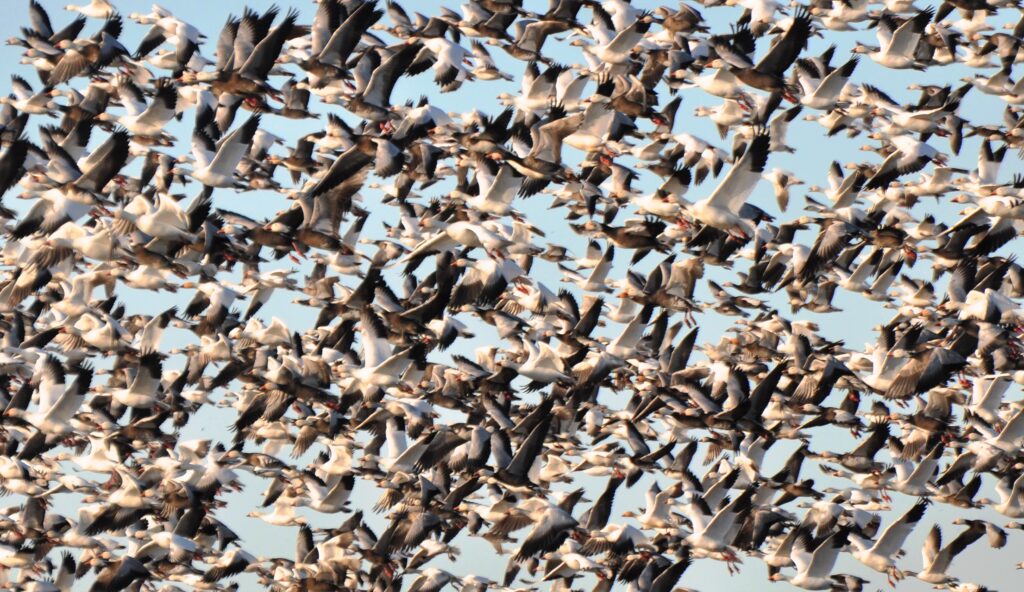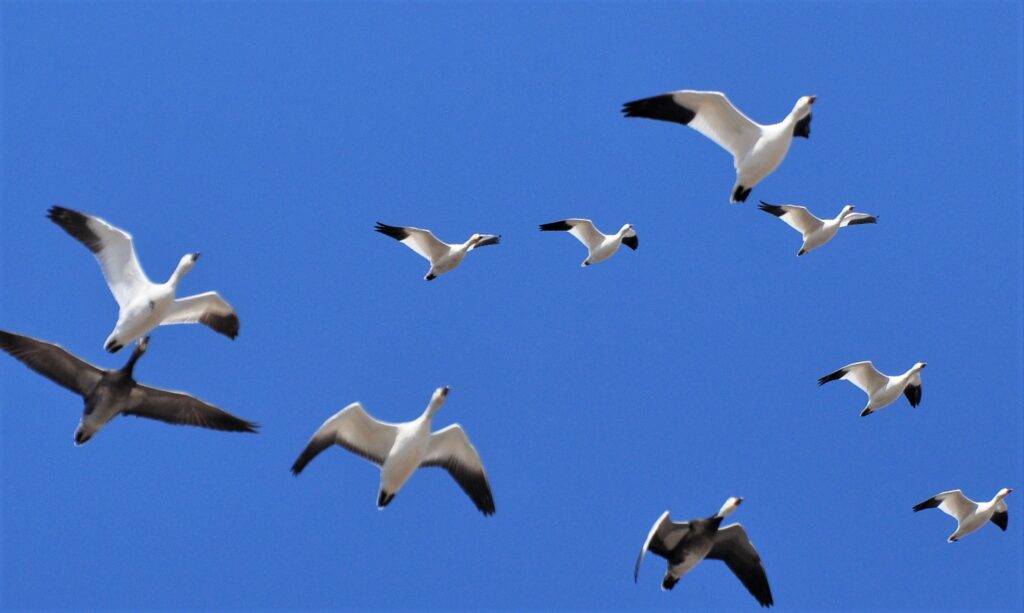Photography courtesy of Lowell Washburn, all rights reserved.
In case you haven’t heard, we’re sitting smack in the path of a fast moving, widespread spring blizzard. Scheduled to arrive any day now, the event will far exceed anything the mid-west has witnessed so far this season. But don’t reach for your shovel just yet. You’ll be glad to learn that this storm doesn’t involve any snow or ice but is instead comprised of feathers and the high-pitched yelping of millions of northbound white geese.

It’s the annual flight of the snow goose and it ranks as one of creation’s most awe-inspiring events. Moving toward ancestral breeding grounds in arctic Canada, snow goose flocks are currently winging their way up the Mississippi Flyway and across Iowa. Pushing hard on the edge of a retreating winter, peak migrations usually occur around mid-March in southern and central Iowa, and a bit later here in the north. But as all Iowans know, the transition from winter to spring weather is an obviously fickle event. Consequently, migrating geese are sometimes forced to make a U-turn as surprise snowstorms force a temporary retreat. In 2015, a whiteout spring blizzard – the kind involving real snow and ice — caused flocks to move south again; with some birds backtracking all the way to northern Arkansas.
But as awe-inspiring as it may be, the spring spectacle is not without environmental consequence. White geese have currently become abundant to the point of severely damaging fragile plant life on tundra nesting areas. In an ongoing effort to stabilize and reduce populations, liberal spring hunting seasons have been allowed by the U.S. Fish & Wildlife Service since 1999. But although a willing legion of hunters have rallied to the cause, spring hunting has had little effect in reducing massive populations.

Historically, snow geese migrated in small family groups or in flocks numbering from 20 to 30 birds. But during the early 1970s, things began to change. Discovering that there is safety in numbers. snow goose survival suddenly began to skyrocket. Instead of surviving for just a handful of seasons at best, breeding adults are now living for a decade or more. Survivors of multiple round-trip migrations, modern-day snow geese have seen and done it all. In the process they have arguably become the wariest birds in the sky. For a hunter to successfully put these flyway veterans in the bag has become the ultimate waterfowling challenge. Rewards can be few and far between. It’s nothing out of the ordinary for groups of hunters to begin setting hundreds of decoys during the wee hours of darkness, sit in those decoys all day, and watch as thousands of migrating snow geese inspect but then shun the spread. When fowlers finally drag from the field at dusk – they are weary and empty handed.

But there are those all too rare occasions when snow goose hunts go exactly as planned. I’ve been in on a few of those when the shrill sound of hundreds of incoming snow geese became deafening and have watched in mesmerized awe as dozens of legion vanguards noisily began landing within ten feet of where I sat surrounded by shimmering windsock decoys. Those are the memories that keep you coming back. Shots or no shots, the spring snow goose migration remains one of the greatest shows on earth.

 Tom Cope
Tom Cope Sue Wilkinson
Sue Wilkinson Susan Judkins Josten
Susan Judkins Josten Rudi Roeslein
Rudi Roeslein Elyssa McFarland
Elyssa McFarland Mark Langgin
Mark Langgin Adam Janke
Adam Janke Joe Henry
Joe Henry Kristin Ashenbrenner
Kristin Ashenbrenner Joe Wilkinson
Joe Wilkinson Dr. Tammy Mildenstein
Dr. Tammy Mildenstein Sean McMahon
Sean McMahon